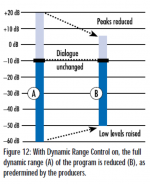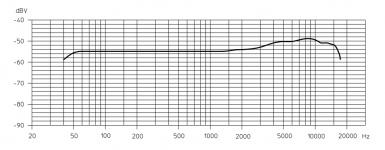I want to add a compressor to my simple mid-fi TV audio system. In order to hear and understand dialog, I need to lower the volume of the action scene booms, blasts and gunshots at times. I do not have or want a receiver or a sound bar system; just a standalone compressor. I don't need any expansion function, either.
Does anyone make a decent sounding variable stereo compressor on a chip that I can build around?
If not on a chip, maybe something smaller than a full rack mount?
Does anyone make a decent sounding variable stereo compressor on a chip that I can build around?
If not on a chip, maybe something smaller than a full rack mount?
Does your DVDs player have a "night mode" in audio option? Best way to go. This is actually a tailored compression track, a guy from Dolby watches the movie ( often with a producer or the director ) and decides how much compression each track of each segment needs mostly reducing the DR of the sound effects and leaving the dialogue. Here's more info:
https://www.dolby.com/us/en/technologies/dolby-digital.pdf
Second best method. Turn up the center speaker. Since 90% of the dialogue is on that track and very little else, that's all you need to do.
3rd best. Use a compressor. This will reduce everything. So if there's dialogue at the same time as loud effects you will loose the dialogue.
If your listening in stereo, your sound is already compromised.
https://www.dolby.com/us/en/technologies/dolby-digital.pdf
Second best method. Turn up the center speaker. Since 90% of the dialogue is on that track and very little else, that's all you need to do.
3rd best. Use a compressor. This will reduce everything. So if there's dialogue at the same time as loud effects you will loose the dialogue.
If your listening in stereo, your sound is already compromised.
The best selection are the NE57X series that rsavas mentions.
The NE571 and NE570 are good but the NE572 is "the bee's rollerskates" (or "bee's knees" according to preference). It is a stereo version with a THD adjustment pin and provision for variable attack and decay times. AUDIO (USA) published some diy articles 30-40 yrs ago. Several in other mags.
May not be easy to source but worth the effort. May also be available with a other letters before the 57X numbers. i.e. 2N57X.......but I'm NOT confident about that.
The NE571 and NE570 are good but the NE572 is "the bee's rollerskates" (or "bee's knees" according to preference). It is a stereo version with a THD adjustment pin and provision for variable attack and decay times. AUDIO (USA) published some diy articles 30-40 yrs ago. Several in other mags.
May not be easy to source but worth the effort. May also be available with a other letters before the 57X numbers. i.e. 2N57X.......but I'm NOT confident about that.
300 Hz to 3400 Hz is telephone landline quality, that won't make the dialogue more intelligible. I think you could better use a 300 Hz high-pass then to get rid of most of the energy of the booms and blasts, possibly with a slight bump around 5 kHz to 10 kHz to improve intelligibility.
(A bump somewhere in the 5 kHz to 10 kHz range is an old trick to make dialogue easier to understand. As an example, see the attached frequency response of the famous Sennheiser MD 21 reporter microphone that has been in production continuously since the 1950's and is still quite popular today.)
(A bump somewhere in the 5 kHz to 10 kHz range is an old trick to make dialogue easier to understand. As an example, see the attached frequency response of the famous Sennheiser MD 21 reporter microphone that has been in production continuously since the 1950's and is still quite popular today.)
Attachments
Last edited:
I've used the FMR Audio RNC 1773 for exactly this use with good results. It prevented Star Wars dialog from disappearing while simultaneously not frightening small children with the excessive SFX.
THAT also makes some Analog Engine chips that can work well if you want to build something. The chips have a VCA and level detector, and sometimes also op amps to be used with the circuits. They have some design notes with details on how to rig up a number of popular circuits using these chips. Design note 118 seems to be appropriate for your uses: http://www.thatcorp.com/datashts/dn118.pdf
THAT also makes some Analog Engine chips that can work well if you want to build something. The chips have a VCA and level detector, and sometimes also op amps to be used with the circuits. They have some design notes with details on how to rig up a number of popular circuits using these chips. Design note 118 seems to be appropriate for your uses: http://www.thatcorp.com/datashts/dn118.pdf
Interesting thoughts here, I'd considered compression for TV but a while ago I got hearing aids due to HF hearing loss and tinnitus, I found I could turn the volume down substantially and hear dialogue better, so, some form of EQ may well help, I'm presuming you don't wear or need hearing aids.
The RNC is fantastic for $199.
Behringer must have a $99 copycat box.
THAT Corp is the king of VCAs and thus compressor/limiter thinking.
I think of NE572 as a super-good telephone chip which needs much additional glue to get music/FX suitable time response. It has been done.
Stealing a THAT plan is IMHO easier and more likely to be on-target.
Buying (sacrilege in a DIY chatroom) the RNC is a pretty sure thing and quick.
Behringer must have a $99 copycat box.
THAT Corp is the king of VCAs and thus compressor/limiter thinking.
I think of NE572 as a super-good telephone chip which needs much additional glue to get music/FX suitable time response. It has been done.
Stealing a THAT plan is IMHO easier and more likely to be on-target.
Buying (sacrilege in a DIY chatroom) the RNC is a pretty sure thing and quick.
Does your DVDs player have a "night mode" in audio option? Best way to go. This is actually a tailored compression track, a guy from Dolby watches the movie ( often with a producer or the director ) and decides how much compression each track of each segment needs mostly reducing the DR of the sound effects and leaving the dialogue. Here's more info:
https://www.dolby.com/us/en/technologies/dolby-digital.pdf
Second best method. Turn up the center speaker. Since 90% of the dialogue is on that track and very little else, that's all you need to do.
3rd best. Use a compressor. This will reduce everything. So if there's dialogue at the same time as loud effects you will loose the dialogue.
If your listening in stereo, your sound is already compromised.
Neat:
"
22. What is the “Midnight Mode” on my new Dolby Digital A/V receiver?
Dolby Digital soundtracks can have a very wide dynamic range between soft and loud sounds. At a full playback level, this can be thrilling, providing a truly theatrical experience, particularly for movies. Late at night, however, the loud sound effects found on some movie soundtracks could disturb your family or neighbors. But if you turn down the volume to “keep the peace,” the dialogue will be hard to hear, and subtle low-level effects may get lost altogether.
What you’d really like to do is turn down the volume on just the loud effects, turn up the volume on quiet sounds, and keep the
dialogue at the same level. This is exactly what Dolby Digital’s Dynamic Range Control feature does. To help explain its function,
manufacturers of Dolby Digital decoders have come up with names like “Midnight Mode” for this feature (see Figure 12).
The amount of compression is not arbitrary, but is decided in advance by the soundtrack’s producers, and coded right onto the soundtrack. Some Dolby Digital decoders let you select various amounts of the available compression (e.g., 50%, 75%, 100%), while others provide only 100% when the compression mode is selected.
"

But what about DTS, AVI ...
Sigh ...
Last edited:
- Status
- This old topic is closed. If you want to reopen this topic, contact a moderator using the "Report Post" button.
- Home
- Source & Line
- Analog Line Level
- Compressor/Expander on a Chip?
